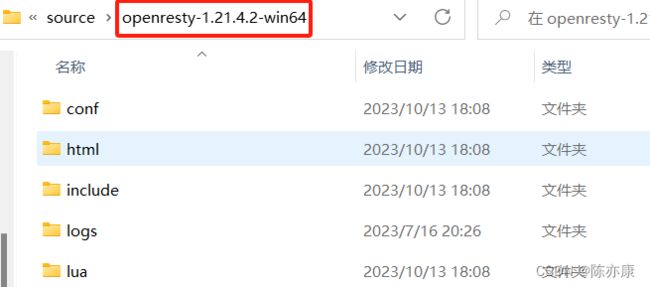Nginx - 反向代理与负载均衡
目录
一、Nginx
1.1、Nginx 下载
1.2、nginx 基础配置的认识
a)第一部分:全局块
b)第二部分:events 块
c)第三部分:http 块
http 块中 内嵌的 server 块
1.3、一些常用配置
1.3.1、location 匹配级别
a)location /
b)location =
c)location ^~
1.3.2、实现反向代理
1.3.3、nginx 配置负载均衡
a)weight 权重
b)ip_hash
c)fair
一、Nginx
1.1、Nginx 下载
a)打开官方网站连接:OpenResty - 下载
选择根据电脑型号自行选择,这里演示 64位 Windows 版,进行下载 zip 文件.
Ps:OpenResty 就是 Nginx.
b)解压缩后,进入以下文件路径.
c)打开,输入 nginx.exe,回车即可,如下:
d)打开网页,访问 localhost:80,即可看到 Nginx 页面(OpenResty 就是 Nginx)
1.2、nginx 基础配置的认识
在 openresty-1.21.4.2-win64\conf\ 路径下有一个 nginx.conf 文件,打开如下:
#user nobody;
worker_processes 1;
#error_log logs/error.log;
#error_log logs/error.log notice;
#error_log logs/error.log info;
#pid logs/nginx.pid;
events {
worker_connections 1024;
}
http {
include mime.types;
default_type application/octet-stream;
#log_format main '$remote_addr - $remote_user [$time_local] "$request" '
# '$status $body_bytes_sent "$http_referer" '
# '"$http_user_agent" "$http_x_forwarded_for"';
#access_log logs/access.log main;
sendfile on;
#tcp_nopush on;
#keepalive_timeout 0;
keepalive_timeout 65;
#gzip on;
server {
listen 80;
server_name localhost;
#charset koi8-r;
#access_log logs/host.access.log main;
location / {
root html;
index index.html index.htm;
}
#error_page 404 /404.html;
# redirect server error pages to the static page /50x.html
#
error_page 500 502 503 504 /50x.html;
location = /50x.html {
root html;
}
# proxy the PHP scripts to Apache listening on 127.0.0.1:80
#
#location ~ \.php$ {
# proxy_pass http://127.0.0.1;
#}
# pass the PHP scripts to FastCGI server listening on 127.0.0.1:9000
#
#location ~ \.php$ {
# root html;
# fastcgi_pass 127.0.0.1:9000;
# fastcgi_index index.php;
# fastcgi_param SCRIPT_FILENAME /scripts$fastcgi_script_name;
# include fastcgi_params;
#}
# deny access to .htaccess files, if Apache's document root
# concurs with nginx's one
#
#location ~ /\.ht {
# deny all;
#}
}
# another virtual host using mix of IP-, name-, and port-based configuration
#
#server {
# listen 8000;
# listen somename:8080;
# server_name somename alias another.alias;
# location / {
# root html;
# index index.html index.htm;
# }
#}
# HTTPS server
#
#server {
# listen 443 ssl;
# server_name localhost;
# ssl_certificate cert.pem;
# ssl_certificate_key cert.key;
# ssl_session_cache shared:SSL:1m;
# ssl_session_timeout 5m;
# ssl_ciphers HIGH:!aNULL:!MD5;
# ssl_prefer_server_ciphers on;
# location / {
# root html;
# index index.html index.htm;
# }
#}
}
这里有很多注释,删除掉以后,如下:
worker_processes 1;
events {
worker_connections 1024;
}
http {
include mime.types;
default_type application/octet-stream;
sendfile on;
keepalive_timeout 65;
server {
listen 80;
server_name localhost;
location / {
root html;
index index.html index.htm;
}
error_page 500 502 503 504 /50x.html;
location = /50x.html {
root html;
}
}
}
这里分开来看,如下:
nginx 配置文件主要有三部分组成:
a)第一部分:全局块
全局块:nginx 服务器全局生效的配置命令
worker_processes 1; # 服务器并发处理能力,值越大并发能力越强(受自身配置限制)
b)第二部分:events 块
events:影响 nginx 和用户网络的连接.
events {
worker_connections 1024; #最大连接数1024个,需灵活配置
}c)第三部分:http 块
http块:包括文件引入、MIME-TYPE 定义,日志自定义、连接超时等.
http {
include mime.types; # 文件扩展名与文件类型映射表
default_type application/octet-stream; # 访问到未定义的扩展名的时候,就默认为下载该文件
sendfile on; # 日志自定义
keepalive_timeout 65; # 超时时间http 块中 内嵌的 server 块
和虚拟主机有关系,主要是未来节省硬件成本.
一个 http 块可以包含多个 server 块,而一个 server 块就等于一个虚拟主机.
server 块中又抱哈了 server 块 和 location 块
全局 server 块:
server {
listen 80; # 目前监听的端口号
server_name localhost; # 主机名称location 块:
location / { #表示默认首页
root html;
index index.html index.htm;
root html 就是根路径,也就是通过 openresty-1.21.4.2-win64\html\ 路径下,去找页面(默认是 index.html 页面,也就是文章开头展示的页面).
最后是对错误页面的描述
error_page 500 502 503 504 /50x.html;
location = /50x.html {
root html;
}如果请求出现了 500、502、503、504 错误,就会进入到 50x.html 页面中(一般不会用这些默认的错误页,因此可以将这个配置也删除掉)。
1.3、一些常用配置
1.3.1、location 匹配级别
拿 echo 插件来举例:echo 就是会像网页上输出一些东西.
这里需要先在 server 中配置 "default_type text/html" ,否则会走默认的 http 块中的下载,如下:
server {
listen 80;
server_name localhost;
default_type text/html;
location / {
echo "hello nginx";
}
}在 openresty-1.21.4.2-win64\ 路径下重新打开一个 cmd 窗口,输入 nginx.exe -s reload 进行重启.
打开浏览器输入 localhost:80 即可访问.
a)location /
/ 就表示匹配以 "/" 开头的所有请求,例如 location/a、location/ajfdioabgua .......
b)location =
= 优先级最高,表示完全匹配,例如 location = /a 就表示只匹配路由 location/a,其他的都不可以.
配置如下:
server {
listen 80;
server_name localhost;
default_type text/html;
location / {
echo "hello nginx";
}
location = /a {
echo "=/a";
}
}cmd 窗口,输入 nginx.exe -s reload 进行重启.
c)location ^~
^~ 优先级比 location / 高,但是匹配规则和 location / 类似. 例如 location ^~ /a 就表示匹配以 /a 开头的所有路由.
例如配置如下:
server {
listen 80;
server_name localhost;
default_type text/html;
location / {
echo "hello nginx";
}
location = /a {
echo "=/a";
}
location ^~ /a {
echo "^~ /a";
}
}重启 nginx 服务.
1.3.2、实现反向代理
修改 nginx.conf 如下:
server {
listen 80;
server_name localhost;
default_type text/html;
location / {
proxy_pass "https://www.baidu.com";
}
}重启 nginx
访问 localhost 即可转到 "https://www.baidu.com".
有一些额外需要注意的如下:
location /a {
proxy_pass http://ip;
}
上述配置会导致你在浏览器中输入以下网址:
localhost/a/xxx => http://ip/a/xxx
location /a/ {
proxy_pass http://ip/;
}
上述配置会导致你在浏览器中输入以下网址:
localhost/a/xxx => http://ip/xxx1.3.3、nginx 配置负载均衡
通过 upstream 来创建一组需要负载均衡服务(默认是轮询策略,如果某个服务器挂了,自动剔除).
upstream group1 {
server 192.168.0.12:80;
server 192.168.0.12:81;
}
server {
listen 80;
server_name localhost;
default_type text/html;
location /a {
proxy_pass "https://group1";
}
}a)weight 权重
另外可以通过 weight 来控制需要负载均衡的权重. 权重越大,访问到的概率越大.
比如将权重都配置为 1,表示两者访问到的概率相同.
upstream group1 {
server 192.168.0.12:80 weight=1;
server 192.168.0.12:81 weight=1;
}
server {
listen 80;
server_name localhost;
default_type text/html;
location /a {
proxy_pass "https://group1";
}
}或者将 80 端口的权重改为 10,让其访问到的概率大一些.
upstream group1 {
server 192.168.0.12:80 weight=10;
server 192.168.0.12:81 weight=1;
}
server {
listen 80;
server_name localhost;
default_type text/html;
location /a {
proxy_pass "https://group1";
}
}b)ip_hash
每个请求按访问 ip 的hash 结果分配,这样子访客固定访问一个后端服务器,可以解决session问题
举个例子:
A用户固定ip,第一次访问到8080 tomcat,那么后面就都是访问到这台机器.
upstream myserver {
ip_hash;
server 127.0.0.1:8080;
server 127.0.0.1:8081;
}
c)fair
根据后端响应时间来分配请求,处理时间短的优先分配.
upstream myserver {
server 127.0.0.1:8080;
server 127.0.0.1:8081;
fair;
}












